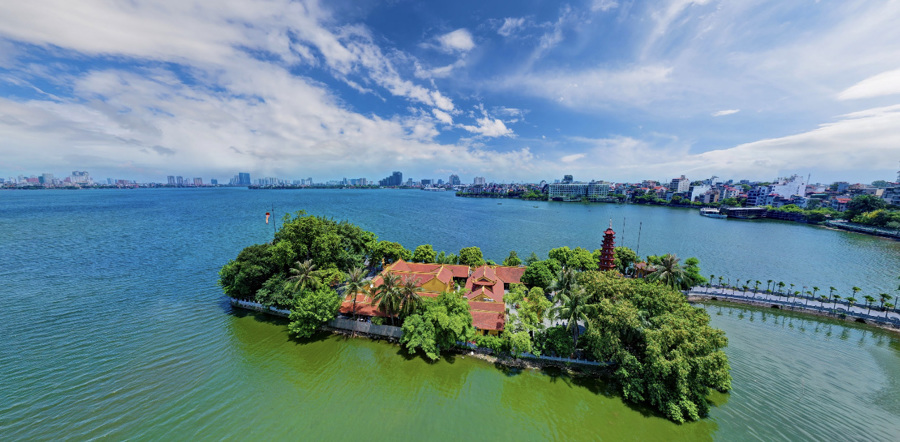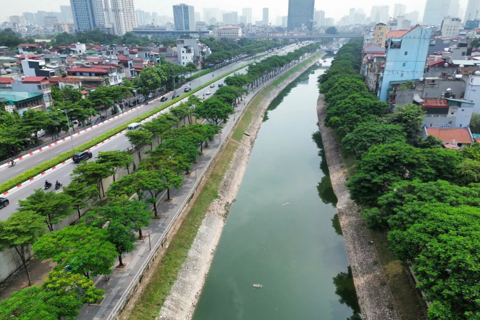Hanoi determined to revitalize “green lungs”
Faced with this urgent issue, Hanoi’s authorities have shown a strong commitment to restoring the lakes in order to make the city greener, cleaner, and more modern.
Hanoi is renowned not only for its cultural heritage but also for its abundance of natural lakes. For centuries, these lakes have shaped the city's unique charm while serving as "green lungs" that help regulate the urban climate.
| West Lake. Photo: Tran Anh/The Hanoi Times. |
Hanoi has long been dedicated to addressing pollution and enhancing the scenic beauty of its lakes, mindful of their crucial role in the city's ecosystem. Today, the capital is home to around 120 lakes, many of which hold deep historical and cultural significance, such as Hoan Kiem Lake, West Lake, and Truc Bach Lake. However, a significant number of these lakes are facing alarming levels of pollution.
The primary cause of this pollution stems from the discharge of untreated wastewater from households and industries directly into the lakes. Additionally, a lack of environmental awareness among some residents has led to widespread littering, which further contributes to sediment buildup, ecosystem imbalance, and foul odors that disturb the surrounding communities.
Faced with this pressing issue, Hanoi’s authorities have demonstrated a strong commitment to restoring the lakes, in order to make the city greener, cleaner, and more modern. A series of comprehensive and timely solutions have been implemented, focusing on improving water quality and raising public awareness about environmental protection.
First, they conducted thorough assessment of pollution levels in each lake to identify the specific causes and develop targeted solutions. This approach ensures that restoration efforts are both effective and cost-efficient. At the same time, dredging and rehabilitation projects have been carried out, along with the construction of advanced wastewater treatment facilities. These initiatives play a critical role in restoring natural ecosystems and improving water quality.
To further protect the lakes, automated monitoring systems have been installed to provide real-time data on water quality, enabling authorities to detect and address pollution issues in a timely manner. In addition, sustainable measures such as expanding green spaces around the lakes, organizing clean-up campaigns, and promoting environmental awareness among residents have been actively pursued.
Mobilizing community involvement has also been a key focus. The city has encouraged social organizations, schools, and businesses to engage in tree-planting initiatives and lake clean-ups, sending a strong message about environmental conservation.
According to representatives from Hanoi’s Drainage Company, regular maintenance efforts, such as collecting floating debris and removing dead fish, have been intensified to ensure that the lakes remain clean. Water levels are also closely monitored to maintain a stable and healthy aquatic environment. Experts agree that making Hanoi a green and clean city requires the collective efforts of the entire society, not just the government.
Hanoi’s determination to tackle lake pollution is ambitious but promising. A prime example of this commitment is the transformation of Linh Quang Lake in Dong Da District. After decades of neglect due to land clearance challenges, the lake has finally been restored, thanks to the city's relentless efforts. Once a stagnant, polluted body of water, Linh Quang Lake has now become a refreshing retreat for local residents.
In addition to preserving and maintaining its lakes, Hanoi has been integrating green spaces and parks into urban planning. The Matrix One Park in Nam Tu Liem District is a standout example, where 95% of the area is dedicated to greenery and a large lake spanning 25,000 square meters.
Experts believe that with continued collaboration between authorities, social organizations, businesses, and residents, Hanoi can fully restore the beauty of its lakes. By transforming them into vibrant urban landmarks, the city not only improves the quality of life for its people but also strengthens its reputation as a sustainable and livable capital, attracting both domestic and international visitors.
| “Hanoi is currently taking numerous measures to protect the city's environment, with a particular focus on its lakes. Many lakes, such as Linh Quang, Đắc Di, and Đống Đa, have been or are being renovated, promising to bring a fresh new look to the capital’s urban landscape. However, despite these efforts, several lakes throughout the city continue to face encroachment and illegal land occupation. To preserve these vital "green lungs," Hanoi must enforce stronger measures,” Associate Professor Dr. Bui Thi An, Director of the Institute of Natural Resources, Environment, and Community Development. |











